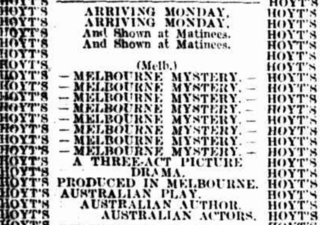
Thunderbolt is a 1910 Australian feature film based on the life of the bushranger Captain Thunderbolt. It was the directorial debut of John Gavin who later claimed it was the first "four-reel movie" made in Australia. It has also been called the first film made in New South Wales.

John F. Gavin was a pioneer Australian film actor and director, one of the early filmmakers of the 1910s. He is best known for making films about bushrangers such as Captain Thunderbolt, Captain Moonlite, Ben Hall and Frank Gardiner. Known informally as 'Jack', Gavin worked in collaboration with his wife Agnes, who scripted many of his films.

The Streets of London is a 1934 Australian film directed by F. W. Thring. It was a filmed version of a play by Dion Boucicault which Thring had produced on stage the previous year. It was the last film made by Efftee Film Productions – Thring ceased production afterwards with the aim of resuming it later but died in 1936 before he had the chance.

Moonlite is a 1910 Australian bushranger film about Captain Moonlite, played by John Gavin, who also directed for producer H.A. Forsyth. It was also known as Captain Moonlite and is considered a lost film.
Agnes Gavin (1872–1947), was an Australian actor and screenwriter in the silent film era. She worked in collaboration with her husband John Gavin throughout her career. She wrote the majority of his films and was arguably the first specialist screenwriter in the history of the Australian film industry. In newspapers she was advertised as the "well known picture dramatizer" and was praised for creating "cleverly constructed stories". Many of her films are considered lost.

The Assigned Servant, or the Life Story of a Deported Convict is a 1911 Australian silent film about a convict who is transported to Van Diemen's Land. It was made by the husband-and-wife team of John and Agnes Gavin and is considered a lost film.

The Mark of the Lash is a 1911 Australian silent film. It is a convict-era melodrama made by the husband-and-wife team of John and Agnes Gavin.

The Martyrdom of Nurse Cavell is a 1916 Australian silent film starring John Gavin about the execution of nurse Edith Cavell during World War I.

A Melbourne Mystery is a 1913 Australian silent film starring John Gavin. Another title is The Unseen Hand.

The Murder of Captain Fryatt is a 1917 Australian silent film about the execution of Captain Charles Fryatt during World War I from John and Agnes Gavin.

Assigned to his Wife is a 1911 Australian silent film from director John Gavin. It is a convict-era "military romantic melodrama".
The Man They Could Not Hang is a 1934 Australian film directed by Raymond Longford about the life of John Babbacombe Lee, whose story had been filmed previously in 1912 and 1921. These silent films were called "one of the greatest box-office features that ever came out of this country." The sound film was not as successful.

The Enemy Within is a 1918 Australian silent film starring renowned Australian sportsman Snowy Baker in his first screen role.
What Women Suffer is a 1911 Australian silent film directed by Alfred Rolfe. It is a Victorian melodrama, complete with a climax where a little child is placed on a moving saw bench and is considered a lost film.
Charles Villiers was an Australian actor and occasional director who appeared in many silent films. According to a contemporary report, "there is probably no actor in Australia that has done more consistent picture work than Mr. Villiers, both as heavy lead, and director." He was particularly well known for playing villains.
The Monk and the Woman is a 1917 Australian silent film directed by Franklyn Barrett. It is considered to be lost.
Australia's Peril is a 1917 Australian silent film directed by Franklyn Barrett. It is considered a lost film.

£500 Reward is a 1918 Australian silent film starring, written, produced, financed and directed by Claude Flemming who later described it as "a very lurid melodrama".
The Australian Photo-Play Company was a short-lived but highly productive Australian film production company which operated from 1911 to 1912.
An Interrupted Divorce is a 1916 Australian short comedy film directed by John Gavin starring popular vaudeville comedian Fred Bluett.












